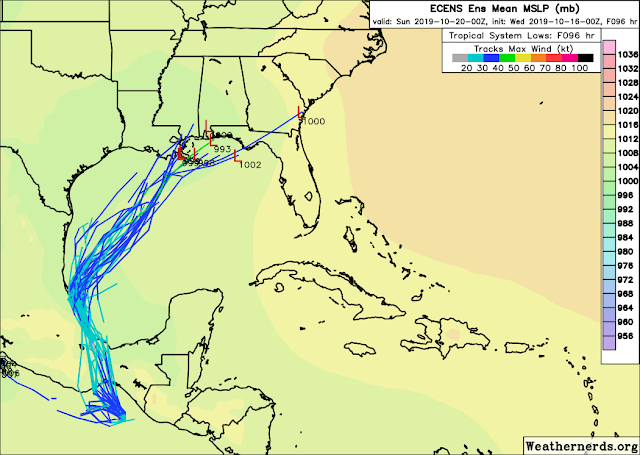Another hurricane season is in the books... and while the official season is six months long, the climatologically most active period can be narrowed down to a third of that: mid-August through mid-October. This was year no exception to that, as 89% of the season's ACE was racked up during those two months. The season ended with 18 named storms, 6 of which became hurricanes, and 3 of which became major hurricanes (Category 3+ on the Saffir-Simpson scale).
In terms of ACE (Accumulated Cyclone Energy), the season ended up at 129% of the average over the past fifty years. Two storms, Dorian and Lorenzo, contributed an impressive 61% of the tally.
The season was dominated by a lot of weak, short-lived storms. 8 of the 18 named storms were of at least tropical storm intensity for two days or less! The most destructive among them was Imelda, which was named for just six hours as it impacted parts of eastern Texas with nearly four feet of rain. Remember, "there's more to the story than the category!"
For the fifth year in a row, a pre-season storm jump-started things. Andrea was a subtropical storm that formed on May 20th and dissipated on the 21st.
By far, the most infamous storm of the season was Dorian, which stalled over the northern Bahamas as a Category 5 hurricane for nearly two days and gave south Florida a good scare as the monster storm refused to leave the area (see "The Unimaginable").
 |
| Hurricane Dorian on September 1, as it made landfall on Marsh Harbour. (CIRA/RAMMB) |
I have the full-sized version of this radar loop and many others from Dorian at http://bmcnoldy.rsmas.miami.edu/tropics/radar/index.html#dorian19
Then later that month, Lorenzo became the easternmost Category 5 hurricane. The third major hurricane was Humberto, which passed by Bermuda as a Category 3 hurricane on September 18.
A noteworthy void of hurricane activity in the track map at the top of this post is the Caribbean Sea and Gulf of Mexico. Only Dorian and Barry were hurricanes in those areas, and for just a few hours each.
The final storm of the season was Sebastien, which stuck around as a tropical storm for a little over five days in the central Atlantic. The last time a season reached the "S" name was 2012: Sandy.
Since I started writing and sharing updates on tropical Atlantic activity in 1996, I've written approximately 1,250 posts spanning 381 tropical cyclones, including 177 hurricanes, 80 major hurricanes, and 44 retired storm names. Thank you for your continued interest! Next year's list begins with Arthur, Bertha, and Cristobal, and there are no new names being introduced since none were retired in 2014.
- Visit the Tropical Atlantic Headquarters.
- Subscribe to get these updates emailed to you.
- Follow me on Twitter









 Rainfall from Potential Tropical Cyclone 16 is reaching Louisiana over to the northern Florida peninsula as of Friday morning. This will continue and become more widespread, and storm surge will also begin to increase for places to the right of the storm's track (with onshore wind). Although it narrowly lacks the organization to be classified as a tropical or subtropical cyclone and earn a name, it now has peak sustained winds of 60 mph. If it does get named, it would be Nestor.
Rainfall from Potential Tropical Cyclone 16 is reaching Louisiana over to the northern Florida peninsula as of Friday morning. This will continue and become more widespread, and storm surge will also begin to increase for places to the right of the storm's track (with onshore wind). Although it narrowly lacks the organization to be classified as a tropical or subtropical cyclone and earn a name, it now has peak sustained winds of 60 mph. If it does get named, it would be Nestor.




 The disturbance that has been a feature of interest for one full week now is finally taking shape in the western Gulf of Mexico. Although it is not forecast to become very strong, it will bring the threats of flooding rain and storm surge to areas from Louisiana to the northern Florida peninsula in the coming days.
The disturbance that has been a feature of interest for one full week now is finally taking shape in the western Gulf of Mexico. Although it is not forecast to become very strong, it will bring the threats of flooding rain and storm surge to areas from Louisiana to the northern Florida peninsula in the coming days.


























 In the far eastern Atlantic, Lorenzo has rapidly intensified to become the season's 3rd major hurricane (Category 3+), with peak sustained winds of 125 mph as of 6am EDT -- just yesterday morning it was at 80 mph. It will almost certainly keep going into Category 4 status, and could even reach Category 5 intensity (160+ mph) at some point. Only about 2% of Atlantic named storms ever achieve Category 5 status, so don't hold your breath.
In the far eastern Atlantic, Lorenzo has rapidly intensified to become the season's 3rd major hurricane (Category 3+), with peak sustained winds of 125 mph as of 6am EDT -- just yesterday morning it was at 80 mph. It will almost certainly keep going into Category 4 status, and could even reach Category 5 intensity (160+ mph) at some point. Only about 2% of Atlantic named storms ever achieve Category 5 status, so don't hold your breath.






